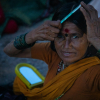Ancient Indian tradition describes food as prana, i.e., life, as food sustains life, and provides nutrition (Swami Gambhirananda 2007:142). Food intake within the same culture varies according to place, family and gender. Fish, for instance is a staple for Bengalis, but all Bengalis do not eat the same kind of fish or prepare it the same way. In many cases women are left with fish of lower nutrient value, while men get fish higher in nutrient value such as rohu and katla. A study of Bengali literature, both fiction and non-fiction, provides ample evidence that the food culture of men and women have differed drastically in the past.
In an Indian family, a boy is ‘generally’ cherished and the birth of a girl is often regarded as inauspicious (Bandyopadhyay 1929:167). In Bengal, the birth of boy was announced by blowing a conch shell, while the birth of a girl was lamented by her father’s family. Hence, it is but natural that food for the girl would differ from that for the boy. The boy gets the greater and better portion of the food and the girl has to manage with the leftovers, a practice which continues even after marriage (Chaudhurani 1992:28). Often, young girls from kulin[1] families were married to old men on the verge of death. Women had to observe various kinds of fasts and perform numerous bratas throughout their lives. All this meant different kinds of food for women.
II
It is true that the calorie requirement of a woman is generally less than a man's, however a woman doing heavy work requires more calories than a sedentary male worker.[2] A survey in Bangladesh has indicated that Asian women are deprived of vital nutrition (in terms of proteins, minerals and vitamins) (Ghosh 1997:102–04). Mudambi and Rajagopal (1990) write, 'nutritional studies have shown that many women attend to the needs of other family members at the expense of their own needs’ (Mudambi and Rajagopal 1990:188–89). In Bengal, in the past, widows' lack of nutrition had a societal sanction. Apart from the strictly plain food that she had everyday, a widow had to observe restrictions on ekadashi and ambubachi.[3]The former came every fortnight while the latter came once a year. The widow, irrespective of her age, had to keep a fast on ekadashi and wasn’t even allowed a drop of water. A widow’s food was strictly vegetarian: parboiled rice and masur (lentils) were not allowed.[4] Vegetables like chichinga (snake gourd) and climbers like pui were barred too.[5] Both parboiled rice and lentil have high nutritional value, but they were banned for widows since these food items were believed to be detrimental to celibacy. They could eat rice only once a day (Chanda 1977:17). Kalyani Dutta, a famous Bengali writer, tells us of an instance where the mother of a child widow would seat her on a wooden seat after she finished her lunch with her palm touching the lunch plate when rice cakes were cooked in winter during poushpaarvan (a festival in the month of poush, when different kinds of rice cake are cooked with jaggery, milk and grated coconut). The widow could eat the rice cakes on the same day since she had not left her seat and had not completed her meal.
Women had a complex relation with food in the past. Asking for food was highly disapproved in 19th-century Bengal; even little girls were taught that expressing one’s hunger was a shameful act (Dasi 2010:32). This was so ingrained in the psyche of Bengali women that they were trained to overlook their nutrition and love for food. Even in cases where a young woman was the head of a household she often was deprived of proper food. She would be so laden with household chores and the number of children to look after that there would be no time left for her to have lunch or dinner. Rassundari Dasi in her autobiography recalls how she had to go without meals for consecutive days while attending to her babies (Dasi 2010:30–32).
Women were never permitted to eat before and in front of the men in the family. The women, no matter how rich a family they belonged to, ate after men had left the dining room. Men used to sit together, but never spoke while eating, whereas women always ate in a group, sharing food and gossip alike. Often, they would eat from the same plate (Devi 1993:43)
Different kinds of food were taboo for women, including eggs or meat of any kind. Fish was their limit of non-vegetarian food which had great importance in a married woman’s life. She had to eat fish or at least touch a fish bone with her teeth on every ekadashi to celebrate her husband’s life (Basu 2010:59). No one would allow a ‘married woman’ to leave the house without offering fish and rice to her.
III
As women of the family ate after men finished their meal, women from middle class families most of the time had to manage with leftovers, which were not sufficient. Hence, they innovated recipes comprising ingredients that could be collected from the neighbourhood. This was starkly different from the dishes prepared for the men. If men ate expensive vegetables and fish bought fresh from market women would eat cheap and easily available leafy vegetables and indigenous herbs like shaak, roots and tubers like kachu etc. (Bandyopadhyay 1929:206) The skin of different vegetables such as patal (parwal), jhinga (bottle gourd) were made into a paste and cooked. The sliced peel of laau (bottle gourd) is still cooked with black cumin and dry red chili powder. Women used mustard oil, mustard paste, coriander leaves, ginger paste etc. to prepare these dishes. Soaked green gram was made into a paste to make vadaas which were deep fried in mustard oil. A popular vadaa that women liked was made of partly rotted coconut with poppy seeds and ataa (flour). Mustard paste was frequently used for cooking daantaachachchari, a dry curry made from the stems of leafy vegetables. These dishes were generally enjoyed with paantaabhaat, leftover rice from the previous night soaked in water. Small fish like punti and mauralaa were cooked into a dry curry for married women (Tagore 1998:421). Kalyani Dutta mentions in her book, Thor Bari Khada that in Calcutta women would buy phuluri (dumplings of lentil paste) from outside to compensate for lunch or dinner (Dutta 1998:22). It was probably difficult to collect vegetables and herbs from a neighbourhood in the city, so they depended on food bought from the market. An array of pastes known as baataa in Bengal was cherished by women, like the one made from coriander leaves and mustard seeds. Kachurshaak (leaves of yam) and kachurlati (stems of yam) were cooked in mustard oil to serve as an important side dish for rice.
Bengali widows belonging to high castes were strict vegetarians and they would also cook a vegetarian spread for the Shaalgraam Shilaa, a small stone form of Narayana. They cooked various shaak (fried leafy vegetables), neem begun (neem leaves fried with diced aubergine), shukto (curry of different vegetables with bitter base and no chillies), daal (lentils) like moong daal with grated coconut, cholaar daal with coconut slices, arhar daal (urad daal), mochaar ghonto (a dry curry of banana fruit), echorer daalnaa (raw jackfruit curry), chhaanaar daalnaa (curry of balls made out of chhena), telpatal (parwal or pointed gourd, mustard oil and poppy paste), the list is endless. The rice always had to be aatap chaal, rice which is not parboiled.
IV
Female gods, like their human counterparts, follow some exclusive food habits. The bhog or prasad (food offering) for Durga is incomplete without paantaabhaat (leftover rice) and kachurshaak (yam leaves). Goddess Kali demands parboiled rice, and less sophisticated fish like boal, magur, sol, kachurshaak and laaughanta with the head of rohu are some of her favourite dishes (Saha, in press). Shaak must be offered to goddess Annapurna along with rice. Ilish and koi are offered to goddess Laxmi. The last two are expensive fishes; however they may signify fish served to a married woman. A host of less-known goddesses, mostly patron goddesses of different villages, are offered foods of their preference. According to the priest of Baladev temple at Kendrapara in Odisha, meals for gods should not contain amla (Indian gooseberry). However, goddess Biraja of Jajpur (in Odisha) is offered amla daily in her lunch. When the priest at Kendrapara was told about this he made an interesting comment, Woh to maa hain naa, maa log sab khaati hain ('she is a mother, mothers eat everything').[6] This tells us a lot about the position of women in India. Women are bound to consume everything, since the best is kept aside for men.
V
Women have also enjoyed a specific kind of community food for ages, savouries which are enjoyed in the afternoons. These are mostly sour in taste, made of raw mango, ripe tamarind, chaaltaa (elephant apple), madar phal, barai, bethul[7] mixed with salt, kaasundi (traditional mustard sauce of Bengal) or mustard oil and green chili. Rani Chanda in her memoir recounts in detail the ways of processing such fruits and vegetables (Chanda 1977:79–80). Thin slices of raw mango were mixed with salt, chili, lime leaves and kaasundi, roasted dry chili and jaggery were used with coarsely pound ripe chaaltaa, barai (sour berries) were enjoyed with shulpaa leaves. Bethul (fruits of cane) were mixed with salt and kaasundi and savoured with delight. The author writes that all these savouries were enjoyed by the women of the house en masse, including older women. These fruits and vegetables were never bought from the market, and were collected by females, mostly in a group from the neighbourhood. They were also prepared in a group, with different females contributing different ingredients. Women perhaps retained their habit of collecting fruits, vegetables or herbs which they might need to compensate for their restricted meals or as a savoury in the afternoon. Replenishing for the used-up food during meals was however given up by women once men and women began eating together.
VI
Food and cooking have been women’s forte for ages, yet they benefited least from the food. Therefore, Bengali women created a parallel cuisine for themselves which consisted of food items rich in taste and nutritious, but that were cost effective. Lamentably these items are now lost from the Bengali platter, and can only be found in a few old cookbooks like Aamish O Niraamish Aahaar (prathamkhanda) by Pragyasundari Devi, Rakamaari Niraamish Ranna by Renuka Devi Chaudhurani. Interestingly, Paak-pranaali, a cookbook written by Bipradas Mukhopadhyay (first published in 1887) has no mention these dishes of plebian origin. This is highly indicative of their being exclusiveness to women, and the author being a man either did not know about these dishes or did not think them to be important enough to find place in a cookbook. Also, Bengali widows innovated a whole range of vegetarian cuisine simply because they did not have the choice of eating non-vegetarian food. These foods today are the hallmark of Bengali cuisine. Social customs led to a systematic segregation of women in terms of food habits, and this in turn engendered a non-ideological unity among them.
Bibliography
Bandyopadhyay, Bibhutibhushan. 1929. Pather Panchal. Kolkata: Mitra O Ghosh Publishers Pvt. Ltd.
Basu, Mira. 2010. Smritir Binaae. Sutradhar.
Chanda, Rani. 1997. Amar Maar Baper Bari. Kolkata: Visva-bharati.
Chaudhurani, Amiya. 1992. Didimaar Jug O Jiban. Kolkata: Mitra O Ghosh Publishers Pvt. Ltd.
Dasi, Rassundari. 2010 [1876]. Aamaar Jiban. Kolkata: National Book Trust.
Devi Chaudhurani, Renuka. 2009. Rakamaari Niraamish Raanaa. Kolkata: Ananda Publishers.
Devi, Giribala. 2003. Raybari. Kolkata: Dey’s Publishing.
Devi, Manoda. 1993. JanaikaBaalikaabadhur Diary. Samatat Prakashan.
Devi, Pragyasundari. 2010. Aamish O NiraamishAahaar (prathamkhanda). Kolkata: Ananda Publishers.
Dutta, Kalyani. 1996. Pinjare Basiyaa. Kolkata: Stree.
——— .1998. Thor Bari Khada. Kolkata: Thema.
Gambhirananda, Swami (ed.) 2007. Prashnopanishad in Upanishad Granthaabali, Vol. I, Udbodhan Karyalay.
Ghosh, Shashwati. 1997. ArdhekArthaniti. Kolkata: Ananda Publishers Pvt. Ltd.
Mudambi, Sumati R. & Rajagopal, M.V. 1990. Fundamentals of Food and Nutrition. Wiley Eastern Ltd.
———. 2007. Fundamentals of Foods, Nutrition and Diet Therapy. New Age International Publishers.
Mukhopadhyay, Bipradas. 2007 [1887]. Paak-pranaali. Kolkata: Ananda Publishers.
Saha, Mausumi Banerjee. In press. ‘Prasaad’ essay forthcoming in Samatat.
Tagore, Rabindranath. Rabindra-Rachanaabali. Vishwabharati.
For help with this article I am thankful to Sri Manmatha Patri, priest, Baladev Temple, Kendrapara, Odisha; Prof. Anindya Bandyopadhyay, Associate Professor, Dept. of English, Katwa College, Burdwan University; Dr. Mausumi Banerjee Saha, Associate Professor, Dept. of Bengali, Dinabandhu Andrews College, Calcutta University.
[1] Kulin are members of the highest-ranking Hindu caste, who were divided into 36 mels, or groups, who could not intermarry.
[2] Sedentary male worker: 2400 calories; female heavy worker: 3000 calories (Mudambi and Rajagopal 1990:273).
[3] Ekadashi is the 11th day of the lunar calendar, which comes twice a month. Ambubachi is celebrated on the Bengali month of Asharh, starting from the seventh day, for a period of three or four days. Bengali widows are forbidden to eat cooked food on these days.
[4] The musur lentil was considered non-vegetarian in Bengal.
[5] Snake gourd resembles penis, that is why it was prohibited for women. But in case of pui the reason is unknown.
[6] Interview with priest Manmatha Patri at Baladeva temple at Kendrapara, Odisha.
[7] These are all sour fruits of Bengal and may found in other parts of India as well.












